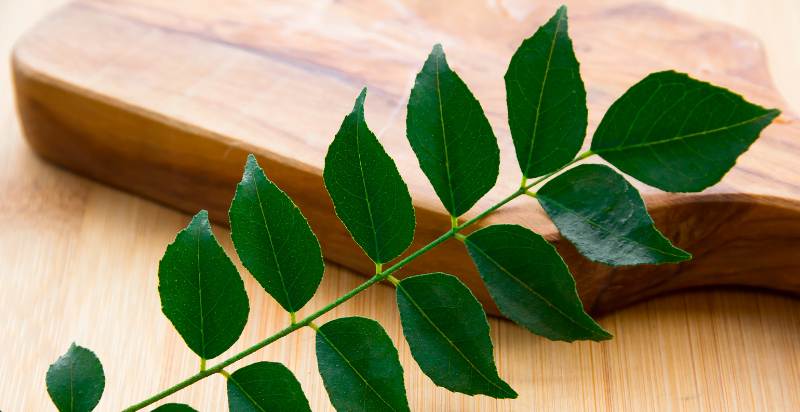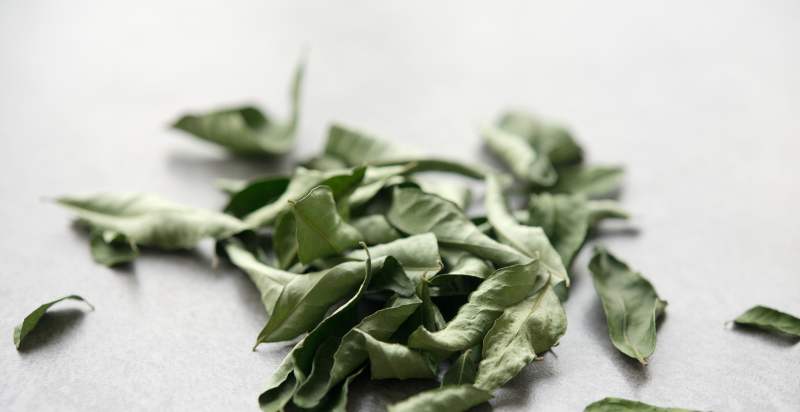Curry leaves are an integral part of South Asian cuisine. The leaf has a distinct flavor and aroma that can add depth to any dish. These leaves may be used either fresh or dried, and some recipes call for the entire leaf, while others require only the stem or the tip. Curries are also made with these leaves, and they provide an interesting flavor to any meal. This article will discuss everything you want to know about curry leaves and how to use them in your cooking.
Description / Taste:
Curry leaves have a distinct and fragrant aroma. They are medium to dark green and have a leathery texture. The leaves are small, measuring 1-2 inches long, with a sharp point at the tip. The taste of these leaves is slightly bitter but also has an earthy flavor that can be sweet if cooked properly.
Seasons / Availability:
Curry leaves are available year-round, but peak season is from April to June. They can be found in most South Asian grocery stores and specialty markets. The leaves may also be purchased online.
Geography / History:
Curry leaves are native to India and have been used in Indian cooking for centuries. They are also used in other South Asian countries such as Sri Lanka, Bangladesh, and Nepal. These leaves are now commonly found in many parts of the world, including Europe, North America, Australia, and New Zealand.
Applications:
Curry leaves are native to India and have been used in Indian cooking for centuries. They are also used in other South Asian countries such as Sri Lanka, Bangladesh, and Nepal. These are now commonly found in many parts of the world, including Europe, North America, Australia, and New Zealand.
Applications of Curry Leaves:
Curry leaves are used as an ingredient in many dishes. They can make curries, soups, stews, stir-fries, and vegetable dishes. The leaves can also be eaten raw or cooked with other ingredients, such as onions, garlic, and ginger. These leaves are often fried in oil until they become crispy. They can also be used to make a flavorful chutney or pickle. Curry leaves are often added to rice dishes, and they also work well in salads.

Storage:
Curry leaves can be stored in an airtight container in the refrigerator for up to one week. They can also be frozen for longer storage, but they will lose some flavor and aroma. If you choose to freeze curry leaves, use them within six months.
Nutritional Information of Curry Leaves:
Curry leaves are rich in vitamins A, B-complex, C, iron, magnesium, and potassium. They also contain antioxidants that help fight free radicals in the body. Studies have shown that consuming curry leaves may reduce the risk of cancer, diabetes, and heart disease.
Preparation of Curry Leaves:
It can be used fresh or dried in many different dishes. The leaves may be added to curries, soups, stews, salads, or even as a garnish for drinks. Fresh leaves should first be washed and then lightly heated in oil before adding them to any dish. Dried curry leaves should be soaked in water until soft and used the same way as fresh ones.
Curry Leaves Health Benefits:
Curry leaves are known to help digestion because of their high fiber content. They are also thought to reduce cholesterol levels and improve blood circulation. Additionally, these leaves have antiseptic properties that can help fight off infections and boost immunity. These leaves are also believed to reduce inflammation in the body and help with weight loss.

How to Use Curry Leaves?
Curry leaves can be used in various dishes to add flavor and aroma. They are commonly used in curries, soups, stews, stir-fries, and vegetable dishes. The leaves can also be eaten raw or cooked with other ingredients, such as onions, garlic, and ginger. These leaves are often fried in oil until they become crispy. They can also be used to make a flavorful chutney or pickle. These are often added to rice dishes, and they also work well in salads.
Overall, these are an incredibly versatile ingredient that can add flavor, aroma, and nutrition to any dish. From curries to soups and stews, these leaves can be used in various dishes to create delicious meals. With their high nutrient content and antiseptic properties, curry leaves are also great for overall health. So why give them a try today?
Conclusion:
Curry leaves are a flavorful and nutritious ingredient used in many Indian dishes. They can be found in most South Asian grocery stores, some specialty markets, and online. It contain vitamins A, B-complex, C, iron, magnesium, and potassium, as well as antioxidants that help fight off free radicals in the body.
These leaves have antiseptic properties that can help fight off infections and boost immunity while reducing inflammation. Curry leaves can be used fresh or dried in many different dishes, such as curries, soups, stews, salads, or even as a drink garnish. Why not give curry leaves a try today? You won’t regret it!
Have you ever heard of curry berries? Dive into our article to uncover the secrets behind curry berries – their origin, unique qualities, and how they might just become your new favorite ingredient in the kitchen!
- Everything You Wanted to Know About Red Tamarillos - June 2, 2025
- A Guide to Tulips: Everything You Need to Know & More… - June 2, 2025
- Guanabana: Description, Flavor, Benefits, And Uses - May 27, 2025

3 thoughts on “Curry Leaves Benefits And Uses”
Comments are closed.